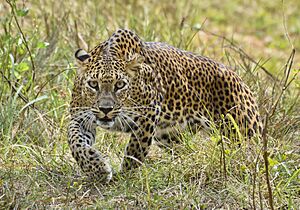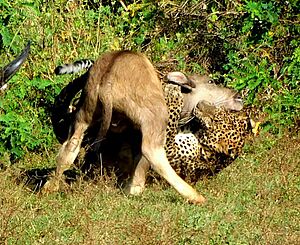Sri Lankan leopard facts for kids
Quick facts for kids Sri Lankan leopard |
|
|---|---|
 |
|
| Sri Lankan leopard in Wilpattu National Park | |
| Conservation status | |
| Scientific classification |
|
| Kingdom: | Animalia |
| Phylum: | Chordata |
| Class: | Mammalia |
| Order: | Carnivora |
| Suborder: | Feliformia |
| Family: | Felidae |
| Subfamily: | Pantherinae |
| Genus: | Panthera |
| Species: | |
| Subspecies: |
P. p. kotiya
|
| Trinomial name | |
| Panthera pardus kotiya Deraniyagala, 1956
|
|
The Sri Lankan leopard (Panthera pardus kotiya) is a special type of leopard found only in Sri Lanka. A Sri Lankan scientist named Paules Edward Pieris Deraniyagala first described it in 1956.
Since 2020, this leopard has been listed as a Vulnerable animal. This means its population is quite small, with fewer than 800 adult leopards left. Their numbers are likely decreasing.
Contents
What Makes Sri Lankan Leopards Special?
The Sri Lankan leopard has a beautiful coat that is yellowish-brown or rusty yellow. It has dark spots and rosettes, which are flower-like patterns.
Female leopards usually weigh around 29 kilograms (64 pounds). They are about 1 meter (3 feet 5 inches) long from head to body, with a tail about 77 centimeters (2 feet 6.5 inches) long. The largest female found was 1.14 meters (3 feet 9 inches) long.
Male leopards are bigger, weighing about 56 kilograms (124 pounds) on average. The largest male recorded weighed 77 kilograms (170 pounds). They can be about 1.27 meters (4 feet 2 inches) long, with a tail about 86 centimeters (2 feet 10 inches) long. The biggest male was 1.42 meters (4 feet 8 inches) long.
These leopards might have grown larger over time because they are the top hunters in Sri Lanka. This means no other animal hunts them. Some people think large males can weigh up to 100 kilograms (220 pounds), but there isn't clear proof of this.
Very rarely, a Sri Lankan leopard can be completely black. These are called melanistic leopards. A few have been seen in places like Mawuldeniya and Nallathanniya. In 2019, wildlife experts filmed a black leopard for the first time.
Where Do Sri Lankan Leopards Live?
Sri Lankan leopards live all over the island of Sri Lanka. You can find them in many different places, both inside and outside protected areas. These areas include:
- Dry areas with less than 1,000 millimeters (39 inches) of rain.
- Areas with medium rainfall, between 1,000 and 2,000 millimeters (39-79 inches).
- Wet areas with more than 2,000 millimeters (79 inches) of rain.
In the central hills of Sri Lanka, leopards live in forests, tea estates, grasslands, and even in people's gardens. They also live in areas with pine and eucalyptus trees.
How Sri Lankan Leopards Live and Hunt

In Yala National Park, Sri Lankan leopards usually hunt alone. The only time they are not alone is when a mother is with her cubs. A male leopard's territory often overlaps with the territories of several females. It also overlaps with parts of other male leopards' territories.
Leopards are most active and prefer to hunt at night. However, they also hunt during dawn, dusk, and even during the day. Unlike some other big cats, they usually don't hide their kills in trees. This might be because there are no other large predators in Sri Lanka that would steal their food.
In 2001 and 2002, scientists estimated that there were about 12 adult leopards and 22 leopards of all ages in every 100 square kilometers (39 square miles) of Yala National Park.
The Sri Lankan leopard hunts by quietly sneaking up on its prey. When it gets close enough, it suddenly bursts forward to catch its victim. It usually kills its prey with a single bite to the throat. Like most cats, leopards eat many different things. Their diet includes small mammals, birds, and reptiles. They also hunt larger animals.
In dry areas, Sri Lankan axis deer are a big part of their diet. They also hunt sambar, barking deer, wild boar, and monkeys.
Life Cycle and Reproduction
Sri Lankan leopards can have babies at any time of the year. There isn't a specific season when most births happen.
In the wild, these leopards usually live for 12 to 15 years. In zoos, they can live even longer, up to 22 years.
The leopard shares its habitat with the Sri Lankan sloth bear.
Dangers to Sri Lankan Leopards
The biggest threats to Sri Lankan leopards are losing their homes and their habitats becoming broken up. More and more, leopards are also being killed by people.
Leopards can accidentally get caught in wire traps set for other animals. Sometimes, people also kill them in revenge if a leopard has attacked their farm animals. This is often done by poisoning the animal carcass. Leopards are also sometimes shot. Since 2010, more than 90 leopards have been killed by people in Sri Lanka.
For example, three leopards died in traps in the Sinharaja conservation area. One of them is now on display at the Giritale Wildlife Museum. In May 2020, the black leopard that was filmed in 2019 was found caught in a trap. It was taken for treatment but sadly died because its neck was badly injured.
Even in large protected areas, human activity near the edges can affect where leopards live. This makes the protected areas smaller for them.
Protecting Sri Lankan Leopards
It's very important to keep studying Sri Lankan leopards. This helps make sure that efforts to protect them are effective. The Leopard Project, run by the Wilderness and Wildlife Conservation Trust (WWCT), works closely with the Sri Lankan government to help leopards. The Sri Lanka Wildlife Conservation Society also plans to do research. The WWCT works all over the island, especially in the central hills where leopard habitats are quickly disappearing.
Leopards in Zoos
As of December 2011, there were 75 Sri Lankan leopards living in zoos around the world. In Europe, 27 male, 29 female, and 8 leopards of unknown gender are part of a special program to help protect the species.
See also
- Leopard subspecies
- Chinese leopard
- Zanzibar leopard



